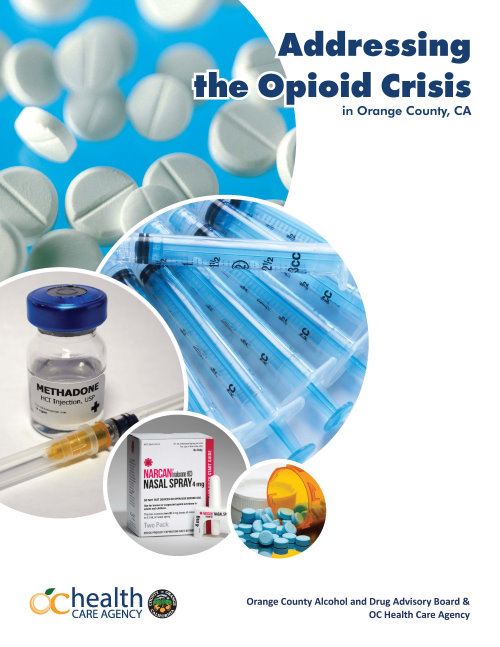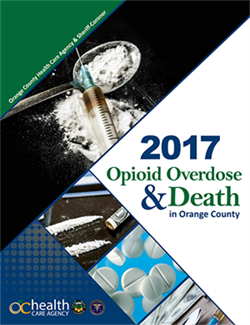Flip Version
Opioid-related overdose deaths have seen a dramatic increase across the nation, state, and county since the 1990s that has only accelerated in the past ten years. In this report we summarize opioid-related morbidity and mortality in Orange County (OC) in the context of these national trends. We examine trends, patterns, and characteristics in opioid-related overdoses/poisonings including emergency department visits, hospitalizations, and deaths in Orange County. From 2017 to 2021, the rate of death due to opioid overdose nearly tripled, from 7.9 deaths per 100,000 to 23.2. The largest increase occurred at the initial year of the COVID-19 pandemic, with the overdose rate rising 88% between 2019 and 2020.
Drug and Alcohol Misuse and Mortality Dashboard
View Dashboard
Drug and Alcohol Deaths Among Youths and Young Adults
The Impact of Synthetic Opioids During the Pandemic
Public Forum to Address Opioid Addiction & Prevention
The County of Orange Health Care Agency hosted this Opioid Forum in partnership with the Alcohol and Drug Advisory Board to bring together people with lived experience, family members, and treatment and community providers together to discuss and learn about a disease that crosses all socioeconomic status. For more information about opioid prevention and treatment resources, visit www.ochealthinfo.com/opioids or send an email opioidinfo@ochca.com to share your input. If you have a loved one who's in need of behavioral health services, call OC Links at 855-625-4657 or live chat online at www.ochealthinfo.com/oclinks.
Resources/ Downloads
Opioid Misuse Prevention and Treatment Resources

The OC Health Care Agency (HCA) presents the “Addressing the Opioid Crisis in Orange County, CA” report, a publication that details the extensive, strategic prevention, harm reduction, treatment and recovery efforts led by the HCA’s Behavioral Health Services team and underway countywide. The report also includes an appendix on behalf of the Orange County Alcohol Drug Advisory Board (ADAB) that summarizes crucial feedback from stakeholders impacted by the opioid crisis.

Drug overdose (poisoning) is now the leading cause of unintentional injury death in the United States, causing more deaths than motor vehicle crashes. Opioids – both prescription and non-prescription – are responsible for most of those deaths. The number of Californians affected by prescription and non-prescription opioid misuse and overdose is substantial, with rates varying significantly across counties, and even within counties. In Orange County, the rate of opioid-related emergency department (ED) visits has increased 141% since 2005 and there were 7,457 opioid overdose/abuse cases treated in the ED between 2011 and 2015. Importantly, seven of every 10 overdose deaths investigated by the Orange County Sheriff-Coroner during this five-year period involved opioids. Learn more in the "2017 Opioid Overdose & Death in Orange County" report.
Opioid Story MapTo combat these climbing statistics, the OC Health Care Agency (HCA) has the following resources available to help you or a loved one who may have a substance use problem:
OC Links
855 OC-LINKS (855-625-4657)
OC Links is an information and referral phone and online chat service to help navigate the Behavioral Health Services (BHS) system within the Health Care Agency for the County of Orange. Callers are connected to clinical Navigators who are knowledgeable in every program within the BHS system. This includes children and adult mental health, alcohol and drug inpatient and outpatient programs, crisis services, and prevention/early intervention programs. Once a program is identified, the Navigator will make every effort to link the caller directly to that program while still on the call or engaged in the chat.
- Hours of operation: Monday through Friday from 8 a.m. to 6 p.m.
Medication Assisted Treatments for Opioid Addiction (MAT)
Vivitrol , Buprenorphine, and Methadone are available MATs for those who meet certain qualifications. For treatment services, please call 855-OC-LINKS.
NAMI WarmLine
877-910-WARM (877-910-9276)
The NAMI WarmLine provides telephone-based, non-crisis support for anyone struggling with mental health and/or substance abuse issues.
- Hours of operation: Monday through Friday from 9 a.m to 3 a.m.; Saturday and Sunday from 10 a.m. to 3 a.m.
24 Hour Suicide Prevention Line
877-7-CRISIS (877-727-4747)
The Suicide Prevention Line provides 24-hour, immediate, confidential over-the-phone suicide prevention services to anyone who is in crisis or experiencing suicidal thoughts. In addition to the resources above, HCA continues to partner with other agencies and organizations to increase awareness and identify solutions for this growing problem. Below is a list of partner organizations and initiatives with which HCA actively participates:
SafeRx OC
Brings together health experts, public health agencies, hospitals, prescribers, community clinics, emergency departments, medical associations and law enforcement, along with key voices, to take action to combat prescription drug abuse and overdose deaths in Orange County, CA.
Medication Disposal
Drop boxes offer a safe location where people can dispose of unused medications, which can help prevent individuals from using medications that were not prescribed to them. Click here for a list of drop-off locations. In addition to the many drop box location sites throughout Orange County, medications can be safely destroyed at home. Learn how to safely dispose of medication(s) from home here.
Alcohol and Other Drug (AOD) Prevention Services Strategic Plan
The strategic plan informs and directs AOD prevention services provided by HCA, which includes Public Health Services' Alcohol and Drug Education and Prevention Team (ADEPT), and Behavioral Health Services' AOD Prevention Services. These prevention services work together under one strategic plan that capitalizes on their complementary strengths.
Opioid Strategic Plan
The Orange County Alcohol and Drug Advisory Board is developing an Opioid Strategic Plan that will identify individual and community needs in Orange County specific to opioids as well as effective strategies to address these needs.
The Solace Foundation
In July 2017, the Orange County Board of Supervisors accepted a grant for 6,218 doses of Naloxone. Naloxone, also known as Narcan, is an opiate antagonist used to reverse the effects of an opiate overdose. Although the grant has ended, Solace Foundation continues to provide Naloxone Distribution and Overdose Recognition & Response Training (ORRT). www.solacefoundationofoc.org
Beneficiary Access Line (BAL)
Access to Drug Medi-Cal (DMC) Services 24 hours per day by calling our Beneficiary Access Line at 1-800-723-8641. The DMC provides and organized delivery system for delivering Substance Abuse Treatment to Medi-Cal beneficiaries in Orange County. The focus of this system is to create a wide array of services designed to treat any and all substance use disorders.
Additional Information:
Guidelines for prescribing opioids for chronic pain.